The Story So Far: The “Master Chief”, a genetically modified “Spartan” supersoldier, is woken up from cryogenic sleep aboard a UNSC cruiser during an attack by an alien alliance known as the Covenant. With no options left and a plan to crash-land the ship on a mysterious artificial ring world nearby, the Master Chief is entrusted with safeguarding the ship’s AI, Cortana. On the surface of the ring the pair regroups with other survivors skirmishing with Covenant forces and formulates a plan to breach a facility that they hope will direct them to the ring’s central control room. In addition to learning that the Covenant worships the race who originally constructed this “Halo” installation, the Forerunners, Cortana discovers a weapons cache which might help turn the tide of the battle. It turns out that this “weapon” is a sample of a parasitic alien species called the Flood. Accidentally released, the Flood quickly begins to spread, overwhelming both the human survivors and Covenant forces alike. With the assistance of the installation’s caretaker, an AI called 343 Guilty Spark, the pair is guided to the ring’s control room so they can activate its defenses. Cortana stops the activation at the last moment, having learned about the nature of the defenses in question – the installation itself is a superweapon designed to combat the Flood by eradicating all sentient life in the galaxy. Not really loving that idea, the pair head to the wreckage of their ship to attempt to trigger a detonation that will destroy the entire installation and prevent Guilty Spark from carrying out its apocalyptic task. Successful, Master Chief and Cortana are able to locate a still-operational fighter in the wreckage and make it off of the installation just in time.
Halo 2 was hotly anticipated by Halo fans everywhere, setting pre-order records and ending up with massive sales and an amazing reception. Despite all of this, I somehow didn’t give too much of a toss about it. The truth is that 2004 was probably the peak of my involvement in online gaming and my clan at the time, The Praetorian Guard, was still playing America’s Army and Planetside as well as dabbling in some MMORPGs, with most of us waiting impatiently for World of Warcraft to finally be released. My brother, who had introduced me to Halo, brought home a copy of Halo 2 in short order too, but the hook didn’t quite stick the second time.
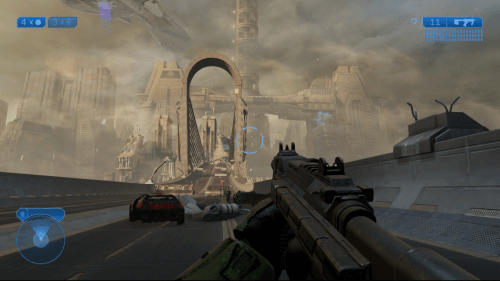
“Back on Earth, at last.”
Halo 2 was quite a different animal than the original Halo: Combat Evolved. The game engine was rebuilt from the ground up and it really showed – the physics felt different, the game looked different, the weapons felt different, etc. On top of that, there were some huge gameplay differences too. One of the more notable ones was the overhaul of the health system. Now instead of having a rechargeable shield layered on top of a more traditional health bar, you simply have rechargeable shields which sit on top of a tiny buffer of unspecified, also regenerating health. This made tracking down health packs a thing of the past and really reinforced the importance of ducking out of combat to quickly recharge. While this feels quite jarring when playing Halo: CE and Halo 2 back to back, once used to it, I think I actually prefer Halo 2’s simplified take.
Another more “back of the box” change was the addition of dual wielding weapons. While nifty, it rarely felt advantageous to me since holding a second weapon came at the expense of being able to chuck grenades or melee attack, two staples of Halo: CE combat. On the other hand, basic melee attacks felt a lot less effective anyway, even if Bungie did decide to add a bit more depth to them by taking into account movement and what weapons you’re holding when calculating damage. Speaking of weapons, shocking at the time, my beloved assault rifle had been traded out for this new battle rifle thing, along with a new (weak and obviously intended to be dual wielded) submachine gun. While I’d eventually warm up to the battle rifle in future Halo games, neither gun felt like an adequate replacement for the assault rifle. There were numerous other weapon differences too, like the shotgun being all but ruined with its lower rate of fire and shorter range, and some new weapons like the Elite’s energy sword and Brute’s brute shot. Most of these special weapons were quite awesome though, thankfully.
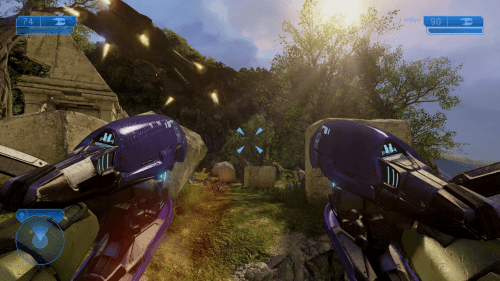
“That said, I love dual wielding plasma rifles.”
Another big change to the core gameplay was to vehicles, and like the aforementioned melee changes, the theme here is added complexity and depth. Unlike in Halo: CE, where vehicles were totally invulnerable, there’s now a vehicle damage system in which the vehicles degrade with damage until they eventually blow up and become unusable. While I sometimes miss Halo: CE’s simpler system, Halo 2’s updates feel more advanced and ultimately much better, even if it can be incredibly disheartening to watch your ride disintegrate around you. The graphical effects of having pieces fly off your vehicle as it gets smashed up by a huge explosion (or a poorly planned jump, as is often the case in the Warthog) definitely only adds to the already impressive spectacle. It also pairs nicely with the new ability to board and assault and/or take over vehicles, critically leveling the playing field a bit more, especially in multiplayer matches.
As for level design, Halo 2’s maps are constrained to open arenas connected by corridors. The larger arenas sometimes come close, but nothing really quite captures the feeling of Halo: CE’s more open environments and battlefields. Despite being more linear, the backtracking and repetitious sections are mostly absent, and even when present, aren’t anything like the more tedious sections of Halo: CE. For better or for worse, Halo 2 feels a lot closer to a modern first person shooter than its predecessor. One other difference I noted was how the later levels often feel more chaotic in Halo 2. “Containment Zone” for example, features some insane battles as Elites, Covenant loyalists, Forerunner drones, and the Flood all go at it, often with an array of vehicles and powerful weapons to spice things up. The insanity translates into more of a challenge on higher difficulties too. Playing this on “Heroic” difficulty once again, many of these encounters felt a bit untuned, with too many enemies that were a bit too bullet-spongy for my tastes, even if they were a bit less frustrating than the harder encounters in Halo: CE.
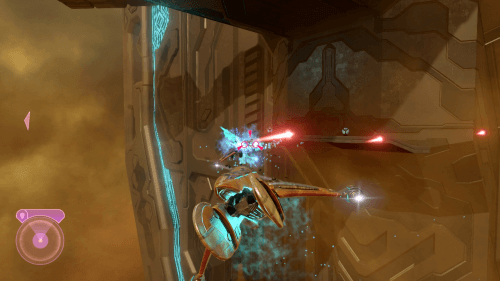
“Hooray for vehicle damage?”
So, while none of the above is bad per say, in fact most people would call most of these changes improvements, for someone who loved Halo: CE but didn’t get caught up in the hype around Halo 2, all added up, it was a bit of a hard pill to swallow. I still dabbled with Halo 2, of course, occasionally playing a few matches of Slayer with my brother and my dad, but it didn’t come anywhere close to pulling me away from my PC. In fact, I don’t think I ever made any real attempt to get into the single player campaign until years later when I made a concerted effort to beat all of my old Xbox games before finally moving on to the Xbox 360.
One aspect of Halo 2 that was closer to universally unpopular was the addition of a second protagonist. You take control of the Arbiter, an Elite who had been entrusted with a series of special missions which has him ultimately crossing paths with the Master Chief by the end of the campaign. A lot of people hated playing this random alien instead of their beloved Spartan, but I and many others actually thought the Arbiter’s story was pretty damn cool, as was the addition of a new Covenant adversary key to this storyline in the powerful Brutes. Perhaps spreading the missions where you play as the Arbiter out a bit more and having less of them overall would have helped avoid people feeling that the Master Chief was being overshadowed, but who knows.
As with last time, for this playthrough I played Halo 2: Anniversary, included with the Xbox One Master Chief Collection. Like with Halo: CE, this was my first time playing the Anniversary edition remaster, so naturally I’ll pick the particulars of this version apart a little too.
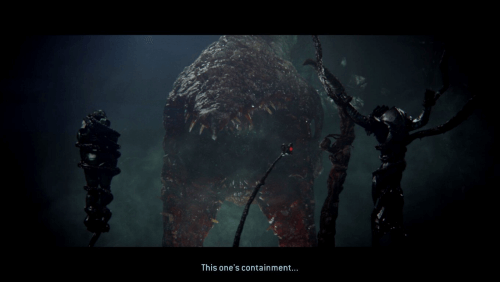
“…and this one’s Great Journey, are the same!”
The first thing that stands out about this new version of Halo 2 are the graphics. While Halo: CE Anniversary still looked a tiny bit rough around the edges in spots, Halo 2: Anniversary is a total triumph. First, they got the legendary Blur to produce beautiful new cinematic cutscenes to replace the previous in-engine ones. These new cutscenes are based directly on the original ones but, with the higher fidelity, they feel a lot more expressive to me. I particularly love the new Gravemind scenes! I also can’t escape the fact that the game, given a similar new “coat of paint” to its in-game graphics as Halo: CE, wears them a lot better. I’d largely attribute it to how much more advanced Halo 2 was – given its release being so late in the cycle of the original Xbox, it was practically an early Xbox 360 game. The remaster being one generation newer, targeted for the Xbox One instead of the Xbox 360, doesn’t hurt either. On top of that, while some areas of the game do look radically different than their original incarnations, for the most part it feels like 343 was much more respectful of the game’s aesthetics this time around. Also, on a totally subjective note, I could never stand how oddly washed out Halo 2 looked, an issue that has been absolutely resolved in this remaster.
Like Halo: CE Anniversary, the sound effects and soundtrack have been completely re-recorded too. The original soundtrack was already a masterpiece, so while which renditions you prefer is definitely a matter of opinion, there’s certainly nothing wrong with the new tracks. On the other hand, as with last time, I find the new mix to be a bit distracting. It’s not quite as bad about overpowering the dialog but it can certainly drown out other sound effects. A great example of this is the level “Uprising” in which the ambient jungle noises and sounds of distant battle are all but missing because the music is so much louder. A nitpick, sure, but these little things do make a difference. Halo 2: Anniversary also includes the awesome on-demand instant swap between old and new aesthetics, which I’m mentioning now, because it also includes swapping between those original and remastered sound effects and the soundtrack now. Excellent.
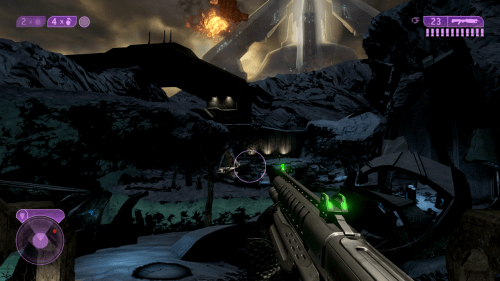
“The Arbiter heading to The Anodyne Spirit on High Charity.”
This new version also revisits the idea of including hidden terminals in each level. The cutscenes triggered by interacting with the terminals focus on the history of the Covenant, and particularly the concept of the Arbiter. Although I did like the terminal cutscenes from Halo CE: Anniversary, I found these ones so much more interesting, and more likely to be appreciated by a first time player too. The additional background on the Arbiter only made me appreciate his role in the story that much more. Very cool stuff. That said, Halo 2’s story (which, like last time, I’ll wait to spoil in the next post) didn’t leave as many seemingly crucial background details out and it’s told in a much more cohesive way overall, so these scenes really do feel like bonus content rather than a necessary attempt to fill in gaps.
In the end, Halo 2 is a mixed bag for me. On one hand, the game still undeniably feels like a bit of a departure from what I loved about Halo: CE. On the other hand, it’s a richer and more skillful effort, and the lovingly crafted makeover it received with Anniversary only reinforces that, feeling almost as easy to pick up and play today as it would have 15 years ago. That is, of course, a massive compliment to both Bungie and 343 alike. How impressed I am with this remaster does make me just a bit nervous to return to Halo 3, which has yet to receive any such overhaul. More on that next time though!
Screenshots taken from the Steam community for the PC version of Halo: The Master Chief Collection.